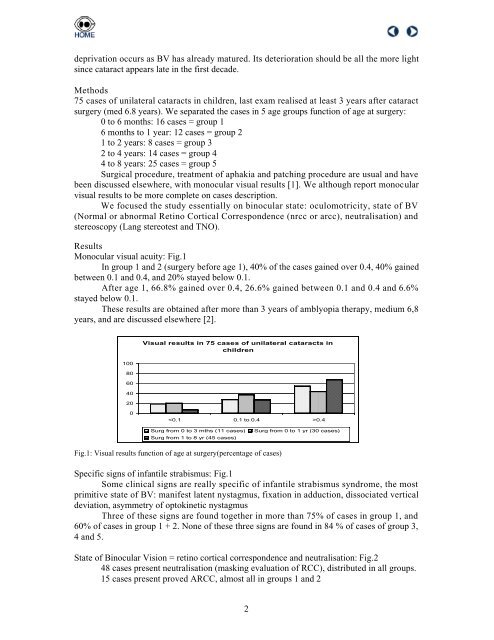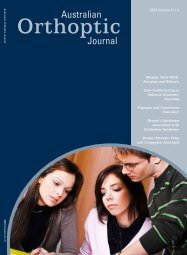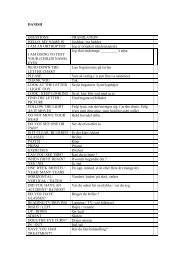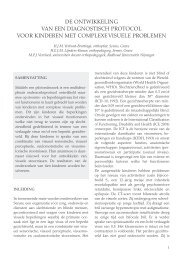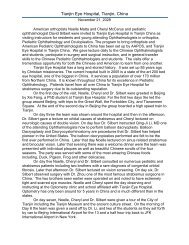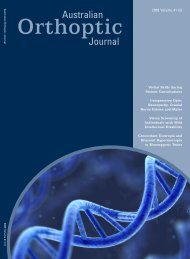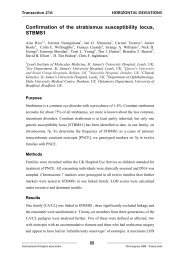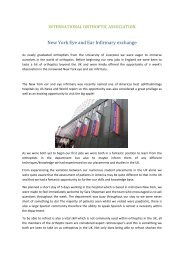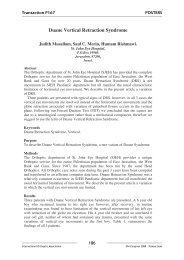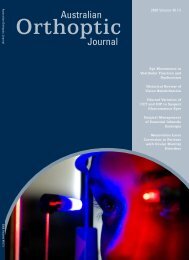Transactions from the Xth International Orthoptics Congress 2004
Transactions from the Xth International Orthoptics Congress 2004
Transactions from the Xth International Orthoptics Congress 2004
Create successful ePaper yourself
Turn your PDF publications into a flip-book with our unique Google optimized e-Paper software.
deprivation occurs as BV has already matured. Its deterioration should be all <strong>the</strong> more light<br />
since cataract appears late in <strong>the</strong> first decade.<br />
Methods<br />
75 cases of unilateral cataracts in children, last exam realised at least 3 years after cataract<br />
surgery (med 6.8 years). We separated <strong>the</strong> cases in 5 age groups function of age at surgery:<br />
0 to 6 months: 16 cases = group 1<br />
6 months to 1 year: 12 cases = group 2<br />
1 to 2 years: 8 cases = group 3<br />
2 to 4 years: 14 cases = group 4<br />
4 to 8 years: 25 cases = group 5<br />
Surgical procedure, treatment of aphakia and patching procedure are usual and have<br />
been discussed elsewhere, with monocular visual results [1]. We although report monocular<br />
visual results to be more complete on cases description.<br />
We focused <strong>the</strong> study essentially on binocular state: oculomotricity, state of BV<br />
(Normal or abnormal Retino Cortical Correspondence (nrcc or arcc), neutralisation) and<br />
stereoscopy (Lang stereotest and TNO).<br />
Results<br />
Monocular visual acuity: Fig.1<br />
In group 1 and 2 (surgery before age 1), 40% of <strong>the</strong> cases gained over 0.4, 40% gained<br />
between 0.1 and 0.4, and 20% stayed below 0.1.<br />
After age 1, 66.8% gained over 0.4, 26.6% gained between 0.1 and 0.4 and 6.6%<br />
stayed below 0.1.<br />
These results are obtained after more than 3 years of amblyopia <strong>the</strong>rapy, medium 6,8<br />
years, and are discussed elsewhere [2].<br />
Visual results in 75 cases of unilateral cataracts in<br />
children<br />
100<br />
80<br />
60<br />
40<br />
20<br />
0<br />
0.4<br />
Surg <strong>from</strong> 0 to 3 mths (11 cases)<br />
Surg <strong>from</strong> 1 to 8 yr (45 cases)<br />
Surg <strong>from</strong> 0 to 1 yr (30 cases)<br />
Fig.1: Visual results function of age at surgery(percentage of cases)<br />
Specific signs of infantile strabismus: Fig.1<br />
Some clinical signs are really specific of infantile strabismus syndrome, <strong>the</strong> most<br />
primitive state of BV: manifest latent nystagmus, fixation in adduction, dissociated vertical<br />
deviation, asymmetry of optokinetic nystagmus<br />
Three of <strong>the</strong>se signs are found toge<strong>the</strong>r in more than 75% of cases in group 1, and<br />
60% of cases in group 1 + 2. None of <strong>the</strong>se three signs are found in 84 % of cases of group 3,<br />
4 and 5.<br />
State of Binocular Vision = retino cortical correspondence and neutralisation: Fig.2<br />
48 cases present neutralisation (masking evaluation of RCC), distributed in all groups.<br />
15 cases present proved ARCC, almost all in groups 1 and 2<br />
2


